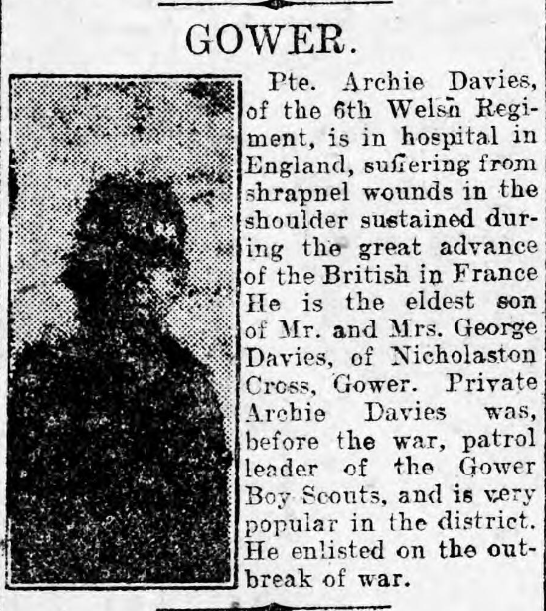Nicholaston
On the road between Penmaen and Oxwich is the small farming community of Nicholaston.
Nicholaston, which names derives from St. Nicholas the name
of the church. Sitting at the foot of
the Cefn Bryn hills, Nicholaston provide stunning views overlooking Three
Cliffs Bay, Oxwich Point and Oxwich Bay.
 |
| St. Nicholas church, Nicholaston |
Situated along the road is the church of St. Nicholas.
There was an early church which was situated nearer to the
sea was dated to the 14th century, was replaced by the present
church. It is a fine example of Victoria
Gothic style. The work was paid by Miss
Olive Talbot, as a memorial to her father C.R.M. Talbot.
 |
| Christopher Rice Mansel Talbot by Alfred, Count D'Orsay, 1834 |
Christopher Rice Mansel Talbot was born 1803, Penrice. His parents were Thomas Mansel Talbot and Mary Lucy Strangaways. It is through his father’s line that he inherited estates at Penrice and Margam. Thomas Mansel Talbot was responsible for the rebuilding of Penrice Castle, starting during 1820.
The work on the church started 1892 and having been completed
by 1894 two months after Olive’s early death in October.
Gower like anywhere else around the United Kingdom, had
young men enlisting to fight during the First World War. And like so many places, many of the those
boy never returned home.
Many of those unfortunate soldiers who were injured during
the war, and they were brought home sadly died from the result of their injuries
or families who didn’t have a body to bury, would commemorate the name of the
fallen on the headstone. St. Nicholas
was no exception.
On the south side the churchyard, two graves contain the
burial of the injured soldier and the name commemorating.
 |
| Archibald Davies' grave St. Nicholas church |
In
Loving Memory Of
Archibald
The Beloved Son Of
George And Eva Davies
Who Died From Wounds Received
In The Battle of Loos
Dec. 15th,
1915, Aged 18 Years
“Greater love hath
no man than this, that
He lay down his
life for his friends”
Archibald Davies was born 1897, Reynoldston. He was the son of Mason George Davies and Eva
Kneath. At the time of the 1911 Census, 14-year-old
Archibald was living with his family at Grove Hill, Parkmill. Archibald was the older brother of George
Ashton, Edward John and Albert Douglas.
 |
| England and Wales Census 2nd April 1911 Grove Hill, Parkmill |
At the outbreak of the First World War, Archibald who was popular in the district, was a patrol leader with the Gower Boy Scouts. Archibald enlisted to serve with the 6th Battalion, Welsh Regiment. After receiving wounds, he conveyed to a hospital in England, and then sadly back home where he lost his life.
 |
| Herald of Wales and Monmouthshire Recorder 23rd October 1915 |
 |
| John Wheale's grave St. Nicholas church |
The next grave, the Wheale family. The inscription in commemorations to John reads
Also Of John Son Of
The Above
Who Was Killed In
Action At
Mametz Woods July
1916
Age 19 Years
His King and
Country Called Him
But The Call Was
Not In Vain
On England’s Roll
Of Honour
You Will Find My
Dear Son’s Name
John Wheale was born 1897, Llandymm, Glamorgan. He was the son of Shepherd/Farmer James Wheale
and Annie Issacs. John had six older siblings,
Sarah Ann, Henry, Mary, William, Ada, and Alice. John also younger siblings, Albert George and
Thomas.
At the time of the 1911 Census, John was living with his widowed
mother, Annie at Perriswood, Penmaen.
John is helping on farm.
 |
| England and Wales Census 2nd April 1911 Perriswood, Penmaen |
John enlisted and joined the 14th Battalion, Welsh Regiment. The 10th July 1916 was the first day that the battalion entered the Mametz Wood. On that first day, John was killed, and his name is on the Thiepval Memorial.
 |
| David Ffrancgo Thomas, Cellist St. Nicholas church |
David Ffrancgon Thomas was the son of Roger Thomas, and he
was named after his father’s heroes singer David Thomas Ffrangeon Davies.
Age 11, David started to play cello under Gwilym
Thomas. Aged 13, David won a scholarship
to the Cello School, London. He went to
win prizes at the national eisteddford at Pontypool, 1924 and Swansea,
1926.
Further studies were made at the Royal Music Academy, where
David won bronze and silver medals. David
a member of a number of orchestras, including the London Philharmonic Orchestra
and the BBC Symphony Orchestra.
During the Second World War, David served army. After the war, studied at Prague. A Welsh orchestra was formed and succeeding holding concert during 1954-55.
 |
| David Ffrancgo Thomas, Cellist |
David died December 1963.

Comments
Post a Comment